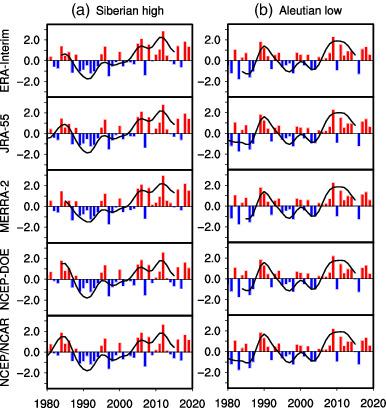当前位置:
X-MOL 学术
›
Atmos. Sci. Lett.
›
论文详情
Our official English website, www.x-mol.net, welcomes your
feedback! (Note: you will need to create a separate account there.)
Decadal variations of the East Asian winter monsoon in recent decades
Atmospheric Science Letters ( IF 2.0 ) Pub Date : 2020-02-05 , DOI: 10.1002/asl.960 Jiapeng Miao 1, 2 , Tao Wang 1, 3
Atmospheric Science Letters ( IF 2.0 ) Pub Date : 2020-02-05 , DOI: 10.1002/asl.960 Jiapeng Miao 1, 2 , Tao Wang 1, 3
Affiliation

|
Observational studies indicated that the East Asian winter monsoon (EAWM) showed significant decadal variations and experienced an interdecadal weakening in the mid‐1980s. How did the EAWM evolve thereafter? In this study, we investigate the decadal variations of the EAWM in the past three decades using five reanalysis datasets and one observational dataset. In total, five members of EAWM system are examined. In the lower troposphere, the Siberian high intensity becomes stronger around 2005 in all five reanalysis datasets, whereas the Aleutian low strengthens in the mid‐1990s and weakens in the mid‐2000s. The two subsystems show opposing changes in the past two decades. In the middle troposphere, the intensity of the East Asian trough remains weakening in recent decades only with some short‐time strengthening around the years of 1995 and 2010. In the upper troposphere, the EAWM index based on the meridional shear of the East Asian jet stream at the 300‐hPa level shows a weak positive trend since the 1990s. It has decadal variations similar to those of the East Asian trough. In the context of these members' changes, the low‐level northerly wind index exhibits two cycles since the year 1980. This index increases in the mid‐1980s, then decreases since the mid‐1990s, and finally increases in the mid‐2000s. Further analysis on the East Asian surface air temperature also reflects similar decadal variations. In summary, unlike the interdecadal shift in the mid‐1980s, the EAWM members (i.e., the Siberian high, the Aleutian low, the low‐level northwesterly wind, the East Asian trough and the East Asian jet stream) do not show consistent decadal variations over the past 30 years. The low‐level members show more significant changes.
中文翻译:

近几十年来东亚冬季风的年代际变化
观测研究表明,东亚冬季风(EAWM)年代际变化显着,并在1980年代中期经历了年代际减弱。此后EAWM如何发展?在这项研究中,我们使用五个重新分析数据集和一个观测数据集来调查EAWM在过去三十年中的年代际变化。总共检查了EAWM系统的五个成员。在对流层低层,所有五个再分析数据集中的西伯利亚高强度在2005年左右变得更强,而阿留申低强度在1990年代中期增强,而在2000年代中期减弱。在过去的二十年中,这两个子系统显示出相反的变化。在对流层中部,近几十年来东亚海槽的强度一直在减弱,仅在1995年和2010年期间出现了短暂的加强。在对流层上部,基于东亚急流在300hPa水平的子午切变的EAWM指数自1990年代以来显示出弱的正趋势。它的年代际变化类似于东亚低谷。在这些成员变化的背景下,低水平的北风指数自1980年以来表现出两个周期。该指数在1980年代中期增加,然后在1990年代中期减少,最后在2000年代中期增加。对东亚地表气温的进一步分析也反映了类似的年代际变化。总之,与1980年代中期的年代际变化不同,EAWM成员(即西伯利亚高压,阿留申低压,西北低风,东亚低谷和东亚急流)没有表现出持续的年代际变化。过去30年的变化。
更新日期:2020-02-05
中文翻译:

近几十年来东亚冬季风的年代际变化
观测研究表明,东亚冬季风(EAWM)年代际变化显着,并在1980年代中期经历了年代际减弱。此后EAWM如何发展?在这项研究中,我们使用五个重新分析数据集和一个观测数据集来调查EAWM在过去三十年中的年代际变化。总共检查了EAWM系统的五个成员。在对流层低层,所有五个再分析数据集中的西伯利亚高强度在2005年左右变得更强,而阿留申低强度在1990年代中期增强,而在2000年代中期减弱。在过去的二十年中,这两个子系统显示出相反的变化。在对流层中部,近几十年来东亚海槽的强度一直在减弱,仅在1995年和2010年期间出现了短暂的加强。在对流层上部,基于东亚急流在300hPa水平的子午切变的EAWM指数自1990年代以来显示出弱的正趋势。它的年代际变化类似于东亚低谷。在这些成员变化的背景下,低水平的北风指数自1980年以来表现出两个周期。该指数在1980年代中期增加,然后在1990年代中期减少,最后在2000年代中期增加。对东亚地表气温的进一步分析也反映了类似的年代际变化。总之,与1980年代中期的年代际变化不同,EAWM成员(即西伯利亚高压,阿留申低压,西北低风,东亚低谷和东亚急流)没有表现出持续的年代际变化。过去30年的变化。











































 京公网安备 11010802027423号
京公网安备 11010802027423号